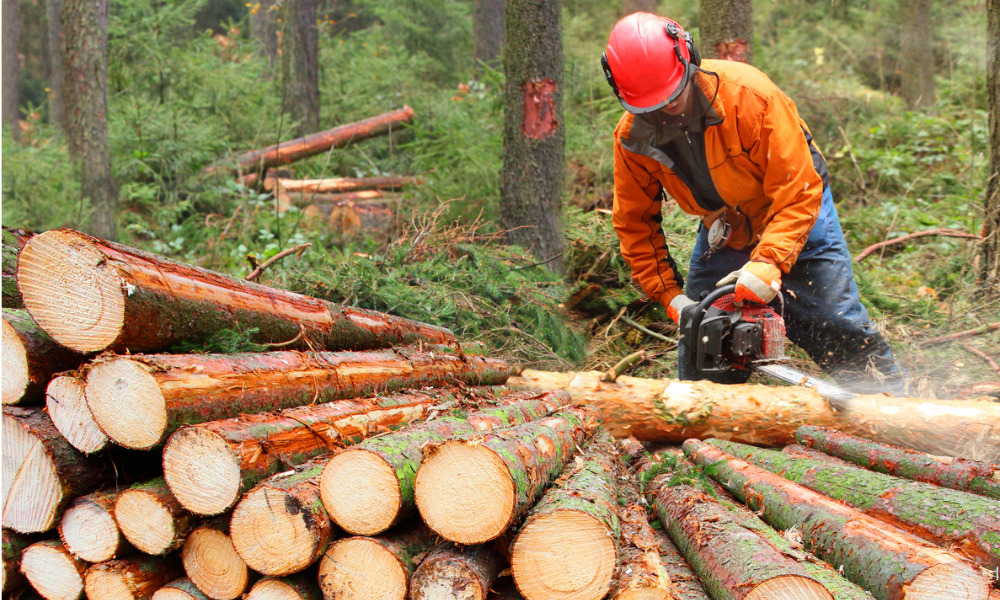Tips for working in logging and sawmill sectors

The forestry industry has made huge strides in safety over the years. In 1992 there were 471 lost time injuries in the industry and according to the latest WSIB statistics there were 31 lost time injuries in 2021.
Despite the progress, there is still room for improvement according to Tom Welton, the director for health and safety services and education programs at Workplace Safety North. He says the industry has seen at least one fatality a year for the past five years, “it continues to be a very high-risk industry and the potential of a severe incident right to the extent of a fatality is always there on a daily basis.”
Workplace Safety North is dedicated to improving safety in the industry and recently received the Canada Award for Excellence in the Healthy Workplace category from Excellence Canada.
The organization assessed the top risk factors in the industry and Welton spoke with Canadian Occupational Safety about those risks, and how to take precautions.
- Workers taking shortcuts
Taking shortcuts in any profession is rarely advised, but when working with heavy machinery and sharp tools it can have dire consequences. One of the more frequent instances of workers taking shortcuts is when a piece of equipment breaks down. Welton says they will often try to fix it in a hurry, “and they may see it as a reflection on them. So, they're trying to move forward and getting that piece of equipment working as quickly as possible.” It can result in the equipment not being fixed correctly or lead to an injury while the maintenance is taking place.
- Machine lockout
Machine lockout means ensuring a piece of equipment is at a zero-energy state. “That means that not only the equipment is locked out from an electrical perspective, but we're looking at pneumatics and all aspects of that piece of equipment moving in any way,” says Welton. It is critical to make sure equipment is cut off from energy sources while it is not in use. But this also applies while performing maintenance and that’s where Welton says sometimes machine lockout gets overlooked. He says heavy machines often need to be raised during maintenance, “but if it is raised, you can't depend on the hydraulics to lock it out. It must be blocked in case the hydraulics fail.” Welton says it is important the machine is fully secured and can not unintentionally move.
- Maintenance
While machine lockout is necessary to perform maintenance, there are other hazards that arise while performing work on a piece of equipment. Welton says while trained mechanics should always do the work, they may not be well versed in a particular piece of machinery. “Appropriate training and guidance, in many cases is provided by the manufacturers and is provided very effectively by the manufacturers but they're not necessarily on site.”
Field maintenance work is also a regular occurrence in the industry, like when a large saw breaks down in the middle of a forest. Welton says these would be less than ideal conditions and without the kinds of tools you would find back in the shop, “and not always with all the equipment that you would see back in the shop, “so in some cases, the workers are required to improvise.” The best solution is to make sure all necessary is equipment is in good working order before it is used in the field.
- Substance use
It goes without saying the use of alcohol or drugs while at a work site is going to lead to an increase in safety risks. It becomes even more consequential when working around heavy and sharp pieces of equipment. “When substance use was identified as a number one risk, and it really blew us away,” exclaims Welton, who says it is not a well documented measurement or statistic. Workplace Safety North has developed a mental health and substance use training programs designed to help workers understand the risks and help supervisors and managers spot the signs of impairment. Part of the education also looks at how to address these issues and support workers who are struggling with a problem.
- Psychosocial- fatigue, distraction, and stress
Welton says the nature of work in the forestry industry leads to long hours, isolation, and often hazardous commutes. “Traveling long distances to get to work and get home on a daily basis and traveling off road and on secondary roads, gravel roads, some roads that aren't maintained,” says Welton, can lead to extreme fatigue and increased levels of stress. Putting in long hours in remote sections of densely wooded areas and driving on sub-standard roads creates the potential for safety incidents. Welton says workers can connect with co-workers using cell phones, radio and other communication devices and should use those tools to decrease the feelings of isolation. It is also advised to take breaks and even naps when necessary to mentally recharge.





